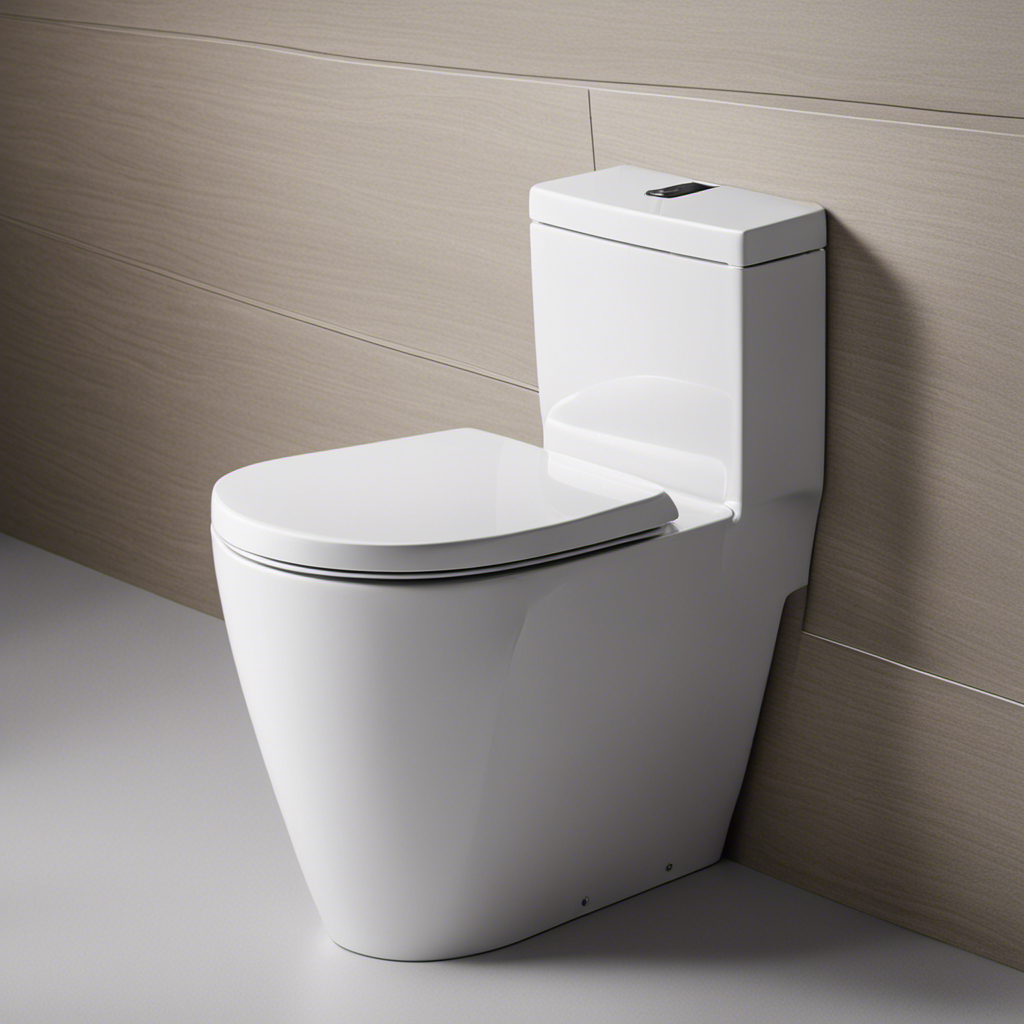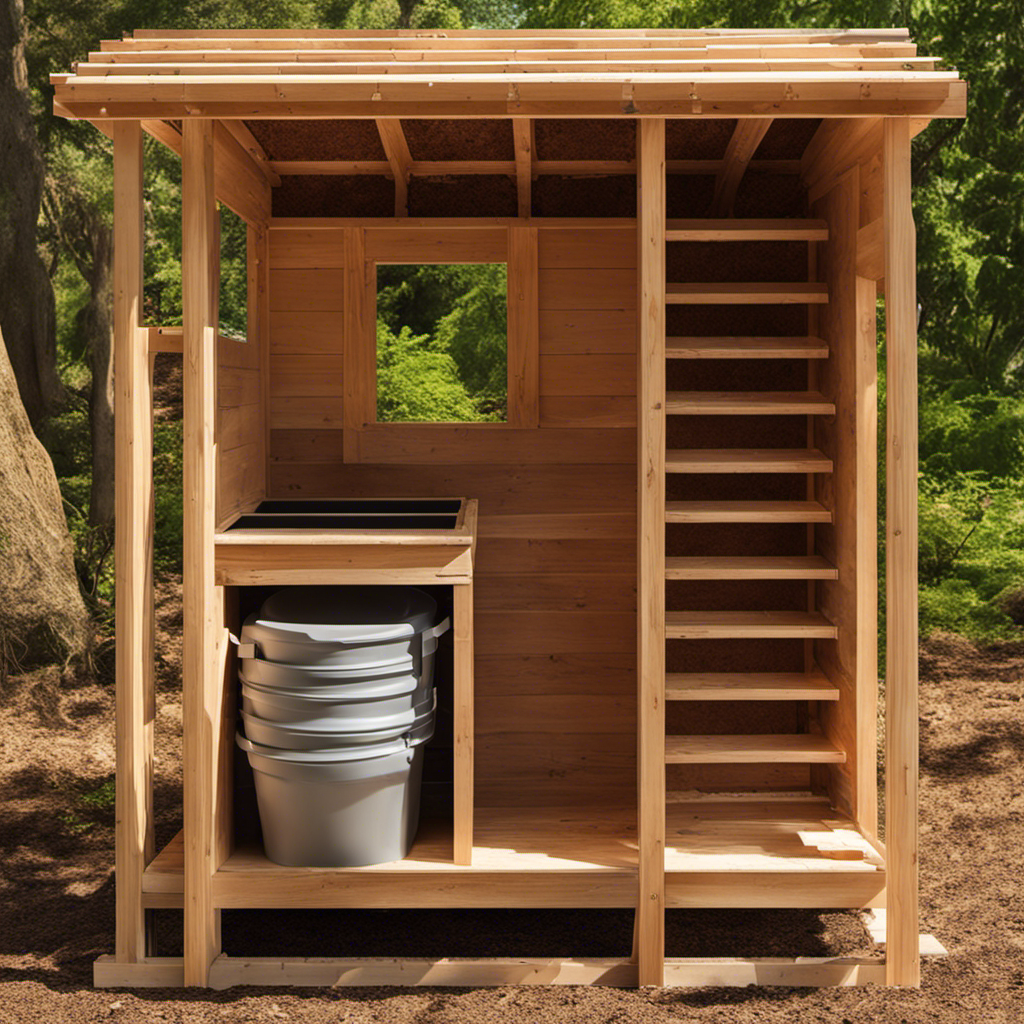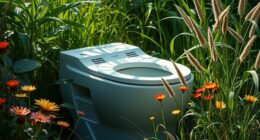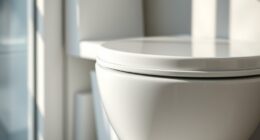I’ll tell you something, folks: we don’t often think about how much water we use when we flush the toilet. But let me tell you, it’s a big deal.
Water efficiency in toilet flushing is crucial for the environment and our wallets. In this article, I’m gonna break it down for you.
We’ll explore the factors that affect water usage, recommended levels for different toilets, and ways to adjust water usage. Trust me, using less water when flushing can make a world of difference.
So let’s dive in and conserve water one flush at a time!
Key Takeaways
- Water conservation is crucial for preserving natural resources and reducing environmental impact.
- Traditional toilets can use up to 5-7 gallons of water per flush, which is highly wasteful.
- Choosing a water-efficient toilet can contribute to water conservation efforts.
- Understanding factors such as toilet type, size of flush valve, and efficiency of fill valve can help reduce water wasted in toilet flushing.
The Importance of Water Efficiency in Toilet Flushing
You should understand the importance of water efficiency when flushing a toilet. Water conservation is crucial for preserving our natural resources and reducing our environmental impact.
When it comes to toilets, using water efficiently can make a significant difference. Traditional toilets can use up to 5-7 gallons of water per flush, which is highly wasteful. However, with water-efficient toilets, also known as low-flow toilets, you can save a significant amount of water with each flush.
These toilets use less water, typically around 1.6 gallons per flush, while still effectively removing waste. By choosing a water-efficient toilet, you can contribute to water conservation efforts and help protect the environment by reducing unnecessary water consumption.
Factors Affecting Water Usage in Toilet Flushing
When it comes to factors affecting water usage in flushing, there are several things you can take into consideration. Factors influencing toilet water consumption include the type of toilet, the age of the toilet, the size of the flush valve, and the efficiency of the fill valve. These factors can have a significant impact on the amount of water used per flush. For example, older toilets typically use more water than newer, water-efficient models. Additionally, larger flush valves can allow more water to flow through, resulting in higher water consumption. On the other hand, efficient fill valves can help regulate the amount of water needed for each flush. By understanding these factors and implementing water conservation measures, we can reduce the amount of water wasted in toilet flushing, contributing to overall water conservation efforts.
| Factors | Influence |
|---|---|
| Type of toilet | Determines water usage |
| Age of toilet | Older toilets use more water |
| Size of flush valve | Affects water flow |
| Efficiency of fill valve | Regulates water consumption |
Recommended Water Levels for Different Types of Toilets
In this discussion, I’ll be exploring the topic of optimal water usage and toilet type variations.
It’s important to understand the recommended water levels for different types of toilets. This knowledge allows us to maximize efficiency and conserve water.
Optimal Water Usage
The optimal water usage for flushing a toilet can vary depending on the type of toilet and its water-saving features. To achieve optimal water conservation and reduce water waste, it is important to understand the water requirements of different toilets. Here is a table summarizing the recommended water levels for various types of toilets:
| Toilet Type | Recommended Water Level |
|---|---|
| Gravity-fed toilets without a tank liner | 1.6 gallons per flush |
| Pressure-assisted toilets | 1.1 to 1.6 gallons per flush |
| Dual-flush toilets | 0.8 to 1.6 gallons per flush |
| High-efficiency toilets (HETs) | 1.28 gallons per flush |
| Waterless composting toilets | No water usage |
Toilet Type Variations
Choosing the appropriate type of toilet is crucial for optimizing water usage and contributing to conservation efforts. With toilet design innovations and water-saving technologies, there are now various options available to help reduce water consumption.
Dual-flush toilets, for example, allow users to select between a lower-volume flush for liquid waste and a higher-volume flush for solid waste. This simple feature alone can significantly reduce water usage.
Another option is the pressure-assisted toilet, which uses air pressure to force water into the bowl, resulting in a more powerful flush with less water.
Water-efficient toilets, on the other hand, use advanced flushing mechanisms to effectively clear waste using minimal water.
By incorporating these toilet design innovations and water-saving technologies, we can make significant strides in conserving water resources and promoting sustainable practices.
Now let’s explore some ways to further adjust water usage in toilet flushing.
Ways to Adjust Water Usage in Toilet Flushing
When it comes to conserving water in the bathroom, efficient flushing techniques and water-saving toilet options are essential.
By implementing efficient flushing techniques, such as using shorter flushes or adjusting the flush volume, we can significantly reduce water usage without compromising the toilet’s functionality.
Additionally, upgrading to water-saving toilet options, such as low-flow or dual-flush toilets, can provide further water conservation benefits, making our bathroom habits more environmentally friendly.
Efficient Flushing Techniques
To save water while flushing the toilet, you can try using the half-flush option if available. Efficient flush mechanisms are designed to reduce water usage without compromising the effectiveness of the flush. These mechanisms utilize dual flush systems, which allow for different amounts of water to be used for liquid waste and solid waste.
The half-flush option uses less water for liquid waste, while the full-flush option is used for solid waste. This water saving technique can significantly reduce water consumption in the bathroom. By incorporating efficient flush mechanisms into toilets, households and businesses can contribute to water conservation efforts and reduce their environmental impact.
Water-Saving Toilet Options
If you’re looking for ways to conserve water, consider exploring water-saving toilet options available on the market. These toilets are equipped with innovative water-saving technology that can significantly reduce your water consumption while still ensuring effective flushing.
Here are some benefits of using eco-friendly toilets:
-
Reduced water usage: Eco-friendly toilets use less water per flush, helping you save hundreds of gallons of water each year.
-
Cost savings: By conserving water, you’ll also save on your water bills, making eco-friendly toilets a financially wise choice.
-
Environmental impact: Using less water in toilet flushing helps preserve our precious water resources and reduces the strain on wastewater treatment plants.
-
Sustainable living: Choosing eco-friendly toilets aligns with a lifestyle that prioritizes sustainability and environmental responsibility.
Benefits of Using Less Water in Toilet Flushing
You can save money on your water bill by using less water when flushing the toilet. Water-saving technologies have been developed to reduce the amount of water used in toilet flushing, which not only saves you money but also has a positive environmental impact.
By installing a low-flow toilet, you can reduce the amount of water used per flush from the standard 3.5 gallons to as little as 1.28 gallons. This can result in significant water savings over time.
Additionally, dual-flush toilets provide the option to use a low-volume flush for liquid waste and a higher-volume flush for solid waste, further reducing water consumption.
These water-saving technologies are designed to be efficient and effective, ensuring that you can maintain the cleanliness and functionality of your toilet while conserving water and protecting the environment.
Tips for Conserving Water While Flushing Toilets
Consider implementing water-saving techniques in your daily routine to reduce unnecessary water usage during toilet flushing. By adopting these strategies, you can significantly contribute to reducing water consumption and conserving this valuable resource. Here are some practical tips to help you achieve this:
-
Install a dual-flush toilet that allows you to choose between a full flush for solid waste and a half flush for liquid waste. This can save a significant amount of water.
-
Place a water displacement device, such as a toilet dam or a plastic bottle filled with water, in the toilet tank. This reduces the amount of water needed to fill the tank after each flush.
-
Consider using recycled or greywater for toilet flushing. This involves diverting water from sources like showers, baths, or laundry for flushing instead of using fresh water.
-
Regularly check for leaks and fix them promptly. Even a small leak can result in significant water wastage over time.
Conclusion
In conclusion, the amount of water needed to flush a toilet is a crucial aspect of water efficiency. By understanding the factors that affect water usage and adjusting the water levels accordingly, we can conserve water without compromising the flushing power.
Just as a skilled artist uses only the necessary strokes to create a masterpiece, we can use only the necessary amount of water to flush our toilets. By doing so, we contribute to a more sustainable future and help preserve this precious resource for generations to come.










